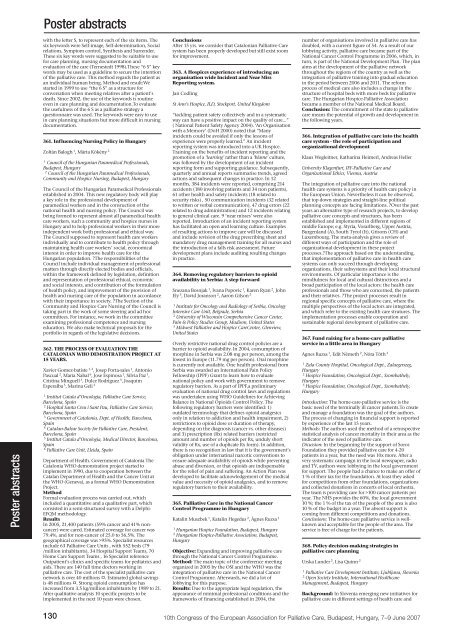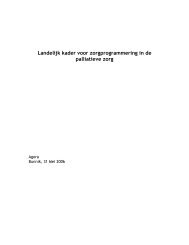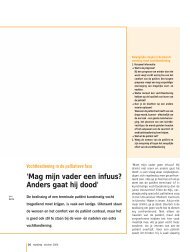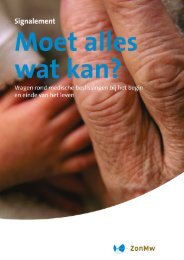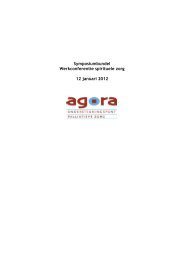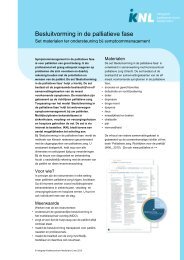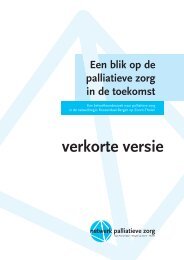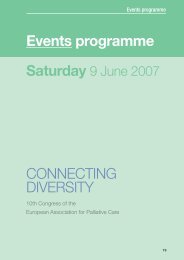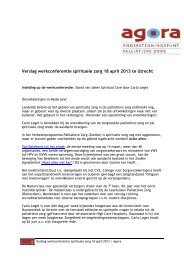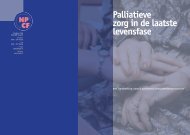Poster abstracts CONNECTING DIVERSITY
Poster abstracts CONNECTING DIVERSITY
Poster abstracts CONNECTING DIVERSITY
You also want an ePaper? Increase the reach of your titles
YUMPU automatically turns print PDFs into web optimized ePapers that Google loves.
<strong>Poster</strong> <strong>abstracts</strong><br />
<strong>Poster</strong> <strong>abstracts</strong><br />
with the letter S, to represent each of the six items. The<br />
six keywords were Self-image, Self-determination, Social<br />
relations, Symptom control, Synthesis and Surrender.<br />
These six key words were suggested to be suitable to use<br />
for care planning, nursing documentation and<br />
evaluation of the care (Ternestedt 1998).These “6 S” key<br />
words may be used as a guideline to secure the intention<br />
of the palliative care. This method regards the patient as<br />
an individual human being. Method and result:We<br />
started in 1999 to use “the 6 S” as a structure for<br />
conversation when meeting relatives after a patient’s<br />
death. Since 2002, the use of the keywords is routine<br />
even in care planning and documentation.To evaluate<br />
the usefulness of the 6 S as a palliative strategy a<br />
questionnaire was used. The keywords were easy to use<br />
in care planning situations but more difficult in nursing<br />
documentation.<br />
361. Influencing Nursing Policy in Hungary<br />
Zoltán Balogh 1 , Márta Kökény 2<br />
1<br />
Council of the Hungarian Paramedical Professionals,<br />
Budapest, Hungary<br />
2<br />
Council of the Hungarian Paramedical Professionals,<br />
Community and Hospice Nursing, Budapest, Hungary<br />
The Council of the Hungarian Paramedical Professionals<br />
established in 2004. This new regulatory body will play<br />
a key role in the professional development of<br />
paramedical workers and in the consruction of the<br />
national health and nursing policy. The Council was<br />
being formed to represent almost all paramedical health<br />
care workers, such a community and hospice nurses in<br />
Hungary and to help professional workers in their more<br />
independent work both professional and ethical way.<br />
The Council supposed to represent health care workers<br />
individually and to contribute to health policy through<br />
maintaining health care workers’ social, economical<br />
interest in order to improve health care for the<br />
Hungarian population. ?The responsibilities of the<br />
Council include individual management of professional<br />
matters through directly elected bodies and officials,<br />
within the framework defined by legislation, definition<br />
and representation of professional ethical, economic<br />
and social interests, and contribution of the formulation<br />
of health policy, and improvement of the provision of<br />
health and nursing care of the population in accordance<br />
with their importance in society. ?The Section of the<br />
Community and Hospice Care Nursing of the Council is<br />
taking part in the work of some steering and ad hoc<br />
committees. For instance, we work in the committee<br />
examining professional competence and nursing<br />
education. We also make technical proposals for the<br />
portfolio in regards of the legislative decisions.<br />
362. THE PROCESS OF EVALUATION THE<br />
CATALONIAN WHO DEMOSTRATION PROJECT AT<br />
15 YEARS.<br />
Xavier Gomez-batiste 1, 3 , Josep Porta-sales 1 , Antonio<br />
Pascual 2 , Maria Nabal 6 , Jose Espinosa 1 , Silvia Paz 1 ,<br />
Cristina Minguell 3 , Dulce Rodriguez 4 , Joaquim<br />
Esperalba 5 , Marina Geli 3<br />
1<br />
Institut Catala d’Oncologia, Palliative Care Service,<br />
Barcelona, Spain<br />
2<br />
Hospital Santa Creu i Sant Pau, Palliative Care Service,<br />
Barcelona, Spain<br />
3<br />
Government of Catalonia, Dept. of Health, Barcelona,<br />
Spain<br />
4<br />
Catalan-Balear Society for Palliative Care, President,<br />
Barcelona, Spain<br />
5<br />
Institut Catala d’Oncologia, Medical Director, Barcelona,<br />
Spain<br />
6<br />
Palliative Care Unit, Lleida, Spain<br />
Department of Health. Government of Catalonia The<br />
Catalonia WHO demonstration project started to<br />
implement in 1990, due to cooperation between the<br />
Catalan Department of Health and the Cancer Unit at<br />
the WHO (Geneva), as a formal WHO Demonstration<br />
Project.<br />
Method<br />
Formal evaluation process was carried out, which<br />
included a quantitative and a qualitative part, which<br />
consisted in a semi-structured survey with a Delphi-<br />
EFQM methodology.<br />
Results<br />
In 2005, 21,400 patients (59% cancer and 41% noncancer)<br />
were cared. Estimated coverage for cancer was<br />
79.4%, and for non-cancer of 25.0 to 56.5%. The<br />
geographical coverage was >95%. Specialist resources<br />
include 63 Palliative Care Units , with 552 beds (79<br />
/million inhabitants), 34 Hospital Support Teams, 70<br />
Home Care Support Teams , 16 Specialist reference<br />
Outpatient’s clinics and specific teams for pediatrics and<br />
aids. There are 140 full time doctors working in<br />
palliative care. The cost of the specialist palliative care<br />
network is over 40 millions ¤. Estimated global savings<br />
is 48 millions ¤. Strong opioid consumption has<br />
increased from 3.5 kg/million inhabitants by 1989 to 21.<br />
After qualitative analysis 10 specific projects to be<br />
implemented in the next 10 years were chosen.<br />
Conclusions<br />
After 15 yrs. we consider that Catalonian Palliative Care<br />
system has been properly developed but still exist room<br />
for improvement.<br />
363. A Hospices experience of introducing an<br />
organisation wide Incident and Near Miss<br />
Reporting system.<br />
Jan Codling<br />
St Ann’s Hospice, ILD, Stockport, United Kingdom<br />
“tackling patient safety collectively and in a systematic<br />
way can have a positive impact on the quality of care…”<br />
( National Patient Safety Agency 2004). ‘An Organisation<br />
with a Memory’ (DoH 2000) noted that “Many<br />
incidents could be avoided if only the lessons of<br />
experience were properly learned.” An incident<br />
reporting system was introduced into a UK Hospice.<br />
Training on the benefits of incident reporting and the<br />
promotion of a ‘learning’ rather than a ‘blame’ culture,<br />
was followed by the development of an incident<br />
reporting form and supporting guidance. Subsequently,<br />
quarterly and annual reports summarise trends, agreed<br />
actions and subsequent changes in practice. In 12<br />
months, 384 incidents were reported, comprising 214<br />
accidents (180 involving patients and 34 non patients),<br />
61 other health and safety incidents (18 related to<br />
security risks) , 50 communication incidents (32 related<br />
to written or verbal communication), 47 drug errors (22<br />
related to drug administration) and 12 incidents relating<br />
to general clinical care. 9 ‘near misses’ were also<br />
reported. Introduction of an incident reporting system<br />
has facilitated an open and learning culture. Examples<br />
of resulting actions to improve care will be discussed<br />
and include revision of the drug prescribing sheet and<br />
mandatory drug management training for all nurses and<br />
the introduction of a falls risk assessment. Future<br />
development plans include auditing resulting changes<br />
in practice.<br />
364. Removing regulatory barriers to opioid<br />
availability in Serbia: A step forward<br />
Snezana Bosnjak 1 , Ivana Popovic 1 , Karen Ryan 2 , John<br />
Ely 3 , David Joranson 2 , Aaron Gilson 2<br />
1<br />
Institute for Oncology and Radiology of Serbia, Oncology<br />
Intensive Care Unit, Belgrade, Serbia<br />
2<br />
University of Wisconsin Comprehensive Cancer Center,<br />
Pain & Policy Studies Group, Madison, United States<br />
3<br />
Midwest Palliative and Hospice CareCenter, Glenview,<br />
United States<br />
Overly restrictive national drug control policies are a<br />
barrier to opioid availability. In 2004, consumption of<br />
morphine in Serbia was 2.08 mg per person, among the<br />
lowest in Europe (11.79 mg per person). Oral morphine<br />
is currently not available. One health professional from<br />
Serbia was awarded an International Pain Policy<br />
Fellowship (IPPF) Grant to learn how to evaluate<br />
national policy and work with government to remove<br />
regulatory barriers. As a part of IPPF,a preliminary<br />
evaluation of national drug control laws and regulations<br />
was undertaken using WHO Guidelines for Achieving<br />
Balance in National Opioids Control Policy. The<br />
following regulatory barriers were identified: 1)<br />
outdated terminology that defines opioid analgesics<br />
only in relation to addiction and health impairment, 2)<br />
restrictions to opioid dose or duration of therapy,<br />
depending on the diagnosis (cancer vs. other diseases)<br />
and 3) prescription (Rx) related barriers (restricted<br />
amount and number of opioids per Rx, unduly short<br />
validity of Rx, use of a duplicate Rx form). In addition,<br />
there is no recognition in law that it is the government’s<br />
obligation under internatinal narcotic conventions to<br />
ensure adequate availability of opioids while preventing<br />
abuse and diversion, or that opioids are indispensable<br />
for the relief of pain and suffering. An Action Plan was<br />
developed to facilitate acknowledgement of the medical<br />
value and necessity of opioid analgesics, and to remove<br />
regulatory barriers to their availability.<br />
365. Palliative Care in the National Cancer<br />
Control Programme in Hungary<br />
Katalin Muszbek 1 , Katalin Hegedus 2 , Ágnes Ruzsa 1<br />
1<br />
Hungarian Hospice Foundation, Budapest, Hungary<br />
2<br />
Hungarian Hospice-Palliative Association, Budapest,<br />
Hungary<br />
Objective: Expanding and improving palliative care<br />
through the National Cancer Control Programme.<br />
Method: The main topic of the conference meeting<br />
organized in 2005 by the OSI and the WHO was the<br />
integration of palliative care in the National Cancer<br />
Control Programme. Afterwards, we did a lot of<br />
lobbying for this purpose.<br />
Results: Due to the appropriate legal regulation, the<br />
appearance of minimal professional conditions and the<br />
frameworks of financing established in 2004, the<br />
number of organisations involved in palliative care has<br />
doubled, with a current figure of 54. As a result of our<br />
lobbying activity, palliative care became part of the<br />
National Cancer Control Programme in 2006, which, in<br />
turn, is part of the National Development Plan. The plan<br />
aims at the development of the palliative network<br />
throughout the regions of the country as well as the<br />
integration of palliative training into gradual education<br />
in the period between 2006 and 2011. The reform<br />
process of medical care also includes a change in the<br />
structure of hospital beds with more beds for palliative<br />
care. The Hungarian Hospice-Palliative Association<br />
became a member of the National Medical Board.<br />
Conclusion: The commitment of the state to palliative<br />
care means the potential of growth and development in<br />
the following years.<br />
366. Integration of palliative care into the health<br />
care system - the role of participation and<br />
organizational development<br />
Klaus Wegleitner, Katharina Heimerl, Andreas Heller<br />
University Klagenfurt, IFF-Palliative Care and<br />
Organizational Ethics, Vienna, Austria<br />
The integration of palliative care into the national<br />
health care systems is a priority of health care policy in<br />
the European Union. Nevertheless it can be observed,<br />
that top down strategies and straight-line political<br />
planning concepts are facing limitations. ?Over the past<br />
years an alternative type of research projects, to develop<br />
palliative care concepts and structures, has been<br />
established and implemented in different regions of<br />
middle Europe; e.g. Styria, Vorarlberg, Upper Austria,<br />
Burgenland (A), South Tyrol (It), Grisons (CH) and<br />
Luxembourg. The meta-analysis gives a review of<br />
different ways of participation and the role of<br />
organizational development in these project<br />
processes.?The approach based on the understanding,<br />
that implementation of palliative care in health care<br />
systems can only succeed through developing<br />
organizations, their subsystems and their local structural<br />
environments. Of particular importance is the<br />
mindfulness for local and cultural distinctions and a<br />
broad participation of the local actors: the health care<br />
professionals and those who are concerned, the patients<br />
and their relatives. ?The project processes result in<br />
regional specific concepts of palliative care, where the<br />
multiple perspectives of the local actors are integrated,<br />
and which refer to the existing health care strutures. The<br />
implementation processes enable cooperation and<br />
sustainable regional development of palliative care.<br />
367. Fund raising for a home-care palliative<br />
service in a little area in Hungary<br />
Agnes Ruzsa 1 , Edit Németh 2 , Nóra Tóth 3<br />
1<br />
Zala County Hospital, Oncological Dept., Zalaegerszeg,<br />
Hungary<br />
2<br />
Hospice Foundation, Oncological Dept., Szombathely,<br />
Hungary<br />
3<br />
Hospice Foundation, Oncological Dept., Szombathely,<br />
Hungary<br />
Introduction: The home-care-palliative service is the<br />
basic need of the terminally ill cancer patients.To create<br />
and manage a foundation was the goal of the authors.<br />
The process of changing in financial support is reported<br />
by experience of the last 15 years.<br />
Methods: The authors used the method of a retrospective<br />
statistical analysis of cancer mortality in their area as the<br />
indicator of the need of palliative care.<br />
Dicussion: In the beganning by the support of Soros<br />
Foundation they provided palliative care for 4-20<br />
patients in a year, but the need was 10x more. After a<br />
very systematic campaign in the local newspaper, radio<br />
and TV, authors were lobbying in the local government<br />
for support. The people had a chance to make an offer of<br />
1 % of their tax for the foundation. At least they asked<br />
for competitions from other foundations, organizations<br />
and collected donations in concerts of local orchestra.<br />
The team is providing care for >100 cancer patients per<br />
year. The NHS provides the 60%, the local government<br />
10 %; the 1 % of the tax of the people of the area is also<br />
10 % of the budget in a year. The absent support is<br />
coming from different competitions and donations.<br />
Conclusions: The home-care palliative service is wellknown<br />
and acceptable for the people of the area. The<br />
service is free of charge for the patients.<br />
368. Policy decision-making strategies in<br />
palliative care planning<br />
Urska Lunder 2 , Lisa Quinn 2<br />
1<br />
Palliative Care Development Institute, Ljubljana, Slovenia<br />
2<br />
Open Society Institute, International Healthcare<br />
Management, Budapest, Hungary<br />
Background: In Slovenia emerging new initiatives for<br />
palliative care in different settings of health care and<br />
130 10th Congress of the European Association for Palliative Care, Budapest, Hungary, 7–9 June 2007


